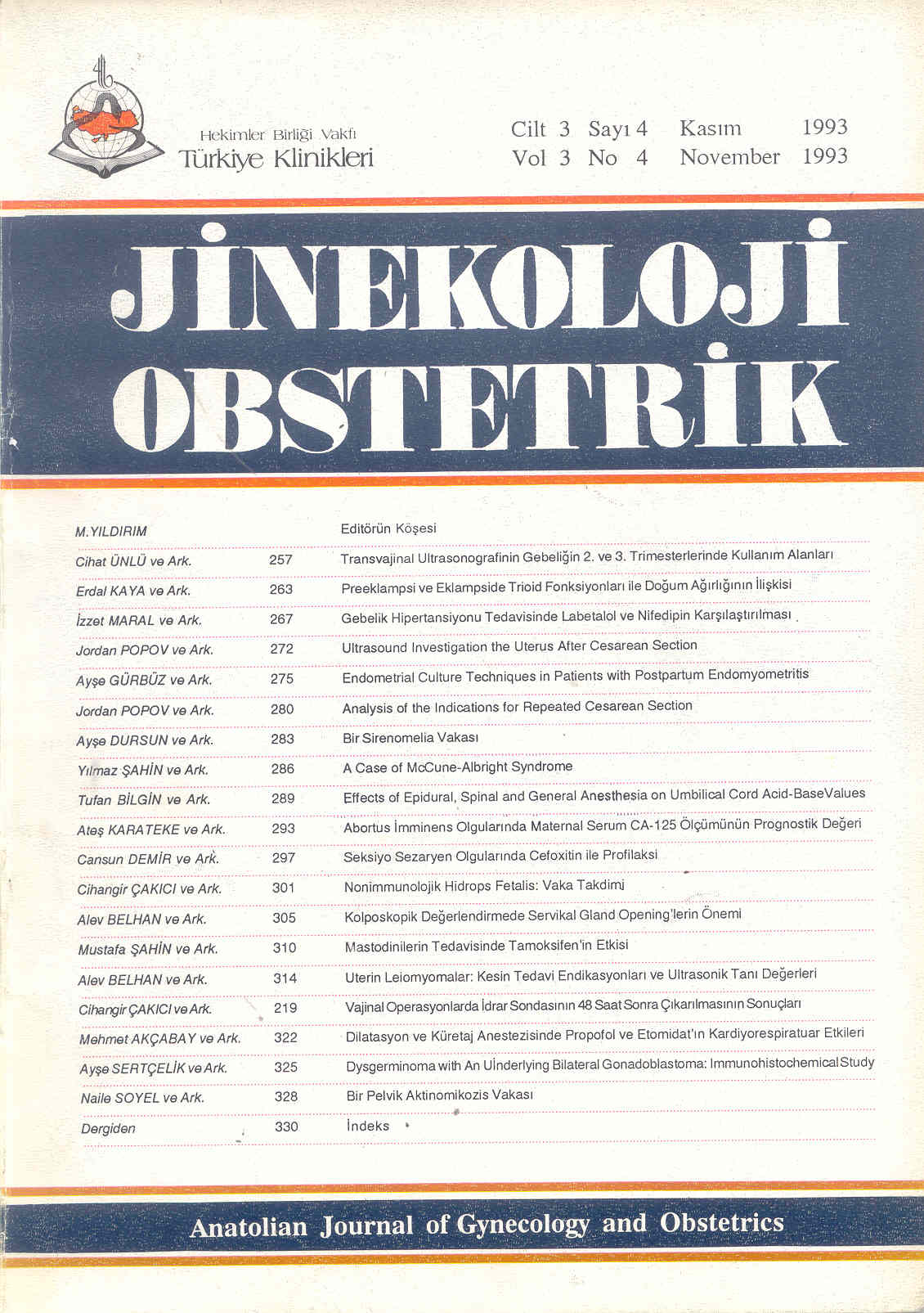Open Access
Peer Reviewed
ARTICLES
2413 Viewed711 Downloaded
The Relation Between Birth Weight And Thyroid Function In Preeclampsia-Eclampsia
Preeklampsi ve Eklampside Tiroid Fonksiyonları ile Doğum Ağırlığının İlişkisi
Turkiye Klinikleri J Gynecol Obst. 1993;3(4):263-6
Article Language: TR
Copyright Ⓒ 2020 by Türkiye Klinikleri. This is an open access article under the CC BY-NC-ND license (http://creativecommons.org/licenses/by-nc-nd/4.0/)
ÖZET
Üçüncü trimesterdeki 37 preeklamptik ve 8 eklamptik gebe ile kontrol grubu olarak 45 sağlıklı gebede tiroid fonksiyonları araştırılarak bu fonksiyonlarla yenidoğanın ağırlığı arasındaki ilişki saptanmaya çalışıldı. Düşük doğum ağırlıklı (DDA) bebek, kontrol grubunda hiç yok iken araştırma grubunda %33.3 oranında bulundu. Preeklamptik-eklamptik olgularda ortalama maternal serum total tiroksin (TT4) 11.76 ± 1.93 mg/dl; total triiyodotironin (TT3) 155.64 ± 35.87 ng/dl; tiroksin bağlayan globulin (TBG) 38.50 ± 8.76 mg/dl ve serbest tiroksin indeksi (ST4I) 10.16±1.96 bulundu. Kontrol grubunda ise TT4 14.70±2.12 ml/dl; TT3 196.41±26.16 ng/dl; TBG 46.60 ± 8.17 µg/dl ve ST4I 11.69±1.68 idi. Preeklamptik-eklamptik grupta bu değerlerle doğum ağırlığı arasında önemli bir korelasyon bulunurken, kontrol grubunda önemli bir korelasyon yoktu. Toksikozlu grupta ortalama maternal serbest tiroksin (ST4) 1.06 ±0.17 ng/dl; serbest triiyodotironin (ST3) 2.80± 0.96 pg/ml; triiyodotironin uptake (T3U) %27.89 ±2.02 ve tiroid stimulan hormon (TSH) 2.03 ±1.35 µIU/ml, kontrol grubunda ST4 1.16±0.22 ng/dl; ST3 3.38±0.85 pg/ml; T3U %26.76±3.04 ve TSH 1.48±0.92 µIU/ml bulundu. Bu değerlere doğum ağırlığı arasında hem toksikozlu, hem de kontrol grubunda önemli bir ilişki bulunmadı. Sonuçlarımız tokseminin şiddetinin DDA infantlara yol açabildiğini, bunun da TT4 ve TT3 hormonlarındaki düşme ile belirlenebileceğini göstermektedir.
Üçüncü trimesterdeki 37 preeklamptik ve 8 eklamptik gebe ile kontrol grubu olarak 45 sağlıklı gebede tiroid fonksiyonları araştırılarak bu fonksiyonlarla yenidoğanın ağırlığı arasındaki ilişki saptanmaya çalışıldı. Düşük doğum ağırlıklı (DDA) bebek, kontrol grubunda hiç yok iken araştırma grubunda %33.3 oranında bulundu. Preeklamptik-eklamptik olgularda ortalama maternal serum total tiroksin (TT4) 11.76 ± 1.93 mg/dl; total triiyodotironin (TT3) 155.64 ± 35.87 ng/dl; tiroksin bağlayan globulin (TBG) 38.50 ± 8.76 mg/dl ve serbest tiroksin indeksi (ST4I) 10.16±1.96 bulundu. Kontrol grubunda ise TT4 14.70±2.12 ml/dl; TT3 196.41±26.16 ng/dl; TBG 46.60 ± 8.17 µg/dl ve ST4I 11.69±1.68 idi. Preeklamptik-eklamptik grupta bu değerlerle doğum ağırlığı arasında önemli bir korelasyon bulunurken, kontrol grubunda önemli bir korelasyon yoktu. Toksikozlu grupta ortalama maternal serbest tiroksin (ST4) 1.06 ±0.17 ng/dl; serbest triiyodotironin (ST3) 2.80± 0.96 pg/ml; triiyodotironin uptake (T3U) %27.89 ±2.02 ve tiroid stimulan hormon (TSH) 2.03 ±1.35 µIU/ml, kontrol grubunda ST4 1.16±0.22 ng/dl; ST3 3.38±0.85 pg/ml; T3U %26.76±3.04 ve TSH 1.48±0.92 µIU/ml bulundu. Bu değerlere doğum ağırlığı arasında hem toksikozlu, hem de kontrol grubunda önemli bir ilişki bulunmadı. Sonuçlarımız tokseminin şiddetinin DDA infantlara yol açabildiğini, bunun da TT4 ve TT3 hormonlarındaki düşme ile belirlenebileceğini göstermektedir.
ANAHTAR KELİMELER: Preeklampsi-eklampsi, tiroid fonksiyonları, doğum ağırlığı
ABSTRACT
Maternal thyroid function was investigated in 37 preeclamptic, 8 eclamptic patients and 45 normal pregnant women in the third trimester as controls. The association between these values and birth weight was investigated. Control group did not concern an infant with small for gestational age (SGA) babies but the ratio of SGA babies were 33.3% in the research group. In the preeclampsia-eclampsia group the mean maternal values were found as total thyroxine (TT4) 11.76 ± 1.93 µg/dl; total triiodothyronine (TT3) 155.64±35.87 ng/dl; thyroxine-binding control group the mean maternal concentrations were seen as TT4 14.70 ±12.2 µg/dl; TT3 196.41±26.16 ng/dl; TBG 46.60±8.17 µg/dl; FT4I 11.69±1.68. there were significant correlations between these values and birth weight of newborn in the patients with preeclampsia-eclampsia, but there was no correlation in the controls. In the toxemia group the mean maternal values were measured to be free thyroxine (FT4) 1.06±0.17 ng/dl; free triiodothyronine (FT3) 2.80±0.96 pg/ml; triiodothyronine uptake (T3U) 27.89 ±2.02%; thyroid stimulating hormon (TSH) 2.03 ±1.35 mIU/ml. In the control group the mean maternal concentrations were found as FT4 1.16±0.22 µg/dl; FT3 3.38 ±0.85 pg/ml; T3U 26.76 ± 3.04±; TSH 1.48 ±0.92 µIU/ml. There was no correlation between FT4, FT3, T3U, TSH and birth weight in the toxemia group or control group. Our results suggest that the severity of preeclampsia and eclampsia may cause SGA infants and this can be shown by reduced plasma concentrations of TT4 and TT3.
Maternal thyroid function was investigated in 37 preeclamptic, 8 eclamptic patients and 45 normal pregnant women in the third trimester as controls. The association between these values and birth weight was investigated. Control group did not concern an infant with small for gestational age (SGA) babies but the ratio of SGA babies were 33.3% in the research group. In the preeclampsia-eclampsia group the mean maternal values were found as total thyroxine (TT4) 11.76 ± 1.93 µg/dl; total triiodothyronine (TT3) 155.64±35.87 ng/dl; thyroxine-binding control group the mean maternal concentrations were seen as TT4 14.70 ±12.2 µg/dl; TT3 196.41±26.16 ng/dl; TBG 46.60±8.17 µg/dl; FT4I 11.69±1.68. there were significant correlations between these values and birth weight of newborn in the patients with preeclampsia-eclampsia, but there was no correlation in the controls. In the toxemia group the mean maternal values were measured to be free thyroxine (FT4) 1.06±0.17 ng/dl; free triiodothyronine (FT3) 2.80±0.96 pg/ml; triiodothyronine uptake (T3U) 27.89 ±2.02%; thyroid stimulating hormon (TSH) 2.03 ±1.35 mIU/ml. In the control group the mean maternal concentrations were found as FT4 1.16±0.22 µg/dl; FT3 3.38 ±0.85 pg/ml; T3U 26.76 ± 3.04±; TSH 1.48 ±0.92 µIU/ml. There was no correlation between FT4, FT3, T3U, TSH and birth weight in the toxemia group or control group. Our results suggest that the severity of preeclampsia and eclampsia may cause SGA infants and this can be shown by reduced plasma concentrations of TT4 and TT3.
MENU
POPULAR ARTICLES
MOST DOWNLOADED ARTICLES





This journal is licensed under a Creative Commons Attribution-NonCommercial-NoDerivatives 4.0 International License.











